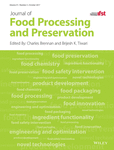Potential uses of sweet potato-wheat composite flour in the pastry industry based on proximate composition, physicochemical, functional, and sensory properties of four pastry products
Funding information: West Africa Agricultural Productivity Programme (WAAPP2A)—Ghana
Abstract
The nutritional, physicochemical, functional properties of sweet potato-wheat composite flour and its sensory attributes in four pastry products were studied. Moisture content of 100% sweet potato flour was significantly (p < .001) lower than 100% wheat flour and sweet potato-wheat composite flours (5%, 10%, 15%, 20%, and 30%). The 100% sweet potato flour had 89.2% carbohydrate and 378.6 kcal of energy per 100 g. The pH of 100% sweet potato flour was significantly (p < .05) lower, compared to 100% wheat flour. Emulsion capacity was higher (52.4%) for sweet potato flour than wheat flour (48.4%). Pasting temperatures were similar for the flours but duration differs. Sweet potato-wheat composite flour substitution levels at 5–15%, 5–20%, and 30% were acceptable for doughnuts, bread, chips, and biscuits, respectively.
Practical applications
There is an increasing demand for pastry products. Sweet potato flour possesses desirable proximate, physicochemical, functional, and sensory properties suitable to partially substitute wheat flour in the pastry industry. This study indicated that sweet potato flour is low in fat and high in vitamins, dietary fiber, and minerals and its composite flour in products were acceptable. Further, the acceptance of the sweet potato composite flour in pastry products addresses the challenge of people who suffer celiac disease associated with the consumption of gluten from cereals.




